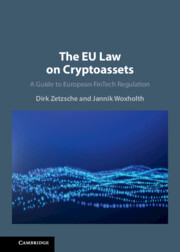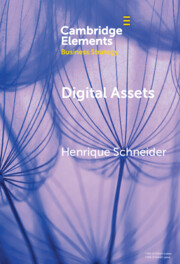107 results
9 - Triple-Entry Accounting, Blockchain, and Next of Kin
- from Part III - Regulations and Compliance of Digital Assets
-
-
- Book:
- Digital Assets
- Published online:
- 06 March 2025
- Print publication:
- 13 March 2025, pp 198-226
-
- Chapter
- Export citation
2 - The Setup of Cryptoasset Schemes
-
- Book:
- The EU Law on Crypto-Assets
- Published online:
- 28 February 2025
- Print publication:
- 06 March 2025, pp 17-29
-
- Chapter
- Export citation

The EU Law on Crypto-Assets
- A Guide to European FinTech Regulation
-
- Published online:
- 28 February 2025
- Print publication:
- 06 March 2025
INTERFERENCE TORTS IN THE DIGITAL ASSET WORLD
-
- Journal:
- The Cambridge Law Journal , First View
- Published online by Cambridge University Press:
- 17 February 2025, pp. 1-28
-
- Article
-
- You have access
- Open access
- HTML
- Export citation
Conversation 6 - Innovation in Financial Services and Supervision
-
- Book:
- Legal Innovation
- Published online:
- 06 February 2025
- Print publication:
- 13 February 2025, pp 146-170
-
- Chapter
-
- You have access
- Open access
- HTML
- Export citation
Empowering Energy: Legal and Regulatory Perspectives on Blockchain-Enabled Trading in Malaysia and Australia
-
- Journal:
- Asian Journal of Law and Society / Volume 11 / Issue 4 / December 2024
- Published online by Cambridge University Press:
- 06 January 2025, pp. 507-529
-
- Article
-
- You have access
- HTML
- Export citation
DAO Token Transferability: Property, Contract, and Technology
-
- Journal:
- European Journal of Risk Regulation , First View
- Published online by Cambridge University Press:
- 27 December 2024, pp. 1-17
-
- Article
-
- You have access
- Open access
- HTML
- Export citation

Digital Assets
- A Portfolio Perspective
-
- Published online:
- 19 December 2024
- Print publication:
- 19 December 2024
-
- Element
- Export citation
14 - Distributive Justice beyond Intellectual Property Laws
- from Part III - Intellectual Property and Global Inequality
-
-
- Book:
- Intellectual Property, Innovation and Economic Inequality
- Published online:
- 05 December 2024
- Print publication:
- 12 December 2024, pp 349-368
-
- Chapter
-
- You have access
- Open access
- HTML
- Export citation
9 - Can Decentralization Encourage Equality in the Patent System?
- from Part II - Intellectual Property and National Inequalities
-
-
- Book:
- Intellectual Property, Innovation and Economic Inequality
- Published online:
- 05 December 2024
- Print publication:
- 12 December 2024, pp 236-251
-
- Chapter
-
- You have access
- Open access
- HTML
- Export citation
7 - New Directions for Organizational Control
- from Part III - Quo Vadis Organizational Control?
-
- Book:
- Reconceptualizing Organizational Control
- Published online:
- 21 November 2024
- Print publication:
- 28 November 2024, pp 257-291
-
- Chapter
- Export citation
13 - The Viability of Blockchain in Corporate Governance
-
-
- Book:
- Board-Shareholder Dialogue
- Published online:
- 31 August 2024
- Print publication:
- 07 November 2024, pp 400-425
-
- Chapter
- Export citation
16 - The Cybersecurity of NFTs and Digital Assets
- from Part V - Data Protection, Privacy, Cybersecurity, and NFTs
-
-
- Book:
- The Cambridge Handbook of Law and Policy for NFTs
- Published online:
- 02 November 2024
- Print publication:
- 17 October 2024, pp 321-334
-
- Chapter
- Export citation
17 - NFTs within the Commercial Supply Chain
- from Part V - Data Protection, Privacy, Cybersecurity, and NFTs
-
-
- Book:
- The Cambridge Handbook of Law and Policy for NFTs
- Published online:
- 02 November 2024
- Print publication:
- 17 October 2024, pp 335-348
-
- Chapter
- Export citation
2 - The Language Landmines of Blockchain Technology and Cryptocurrency
- from Part I - Introduction and Background
-
-
- Book:
- The Cambridge Handbook of Law and Policy for NFTs
- Published online:
- 02 November 2024
- Print publication:
- 17 October 2024, pp 38-56
-
- Chapter
- Export citation
15 - Fungibility, Information Flow, and Privacy
- from Part V - Data Protection, Privacy, Cybersecurity, and NFTs
-
-
- Book:
- The Cambridge Handbook of Law and Policy for NFTs
- Published online:
- 02 November 2024
- Print publication:
- 17 October 2024, pp 299-320
-
- Chapter
- Export citation
19 - Resolving NFT and Smart Contract Disputes
- from Part VI - Other Legal Issues with NFTs
-
-
- Book:
- The Cambridge Handbook of Law and Policy for NFTs
- Published online:
- 02 November 2024
- Print publication:
- 17 October 2024, pp 372-394
-
- Chapter
- Export citation
3 - The Economic Reality of NFT Securities
- from Part II - Financial Regulation and Investor Protection
-
-
- Book:
- The Cambridge Handbook of Law and Policy for NFTs
- Published online:
- 02 November 2024
- Print publication:
- 17 October 2024, pp 59-77
-
- Chapter
- Export citation
12 - Unauthorized Minting and NFTs
- from Part IV - Intellectual Property and Ownership Rights
-
-
- Book:
- The Cambridge Handbook of Law and Policy for NFTs
- Published online:
- 02 November 2024
- Print publication:
- 17 October 2024, pp 238-253
-
- Chapter
- Export citation
9 - Power to the People
- from Part III - Capital Markets, Community, and Marketing
-
-
- Book:
- The Cambridge Handbook of Law and Policy for NFTs
- Published online:
- 02 November 2024
- Print publication:
- 17 October 2024, pp 179-195
-
- Chapter
- Export citation


